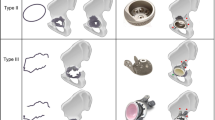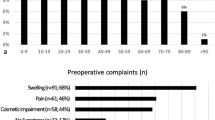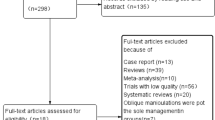Abstract
Objectives
To evaluate lesion filling and other factors that could affect the clinical outcomes of cementoplasty for pelvic bone metastases.
Methods
We retrospectively reviewed the files of 40 patients treated for 44 pelvic bone metastases, collected the parameters related to patients (pain relief evaluated on a visual analog scale, subsequent fractures, and need for surgery), lesions (size, cortical breach score, fracture, soft-tissue extension), and cementoplasty procedures (number of needles, volume of cement, percentage of lesion filling, cement leaks, residual acetabular roof defect), and performed a statistical analysis.
Results
The lesions were on average 43.2 mm in diameter and the mean cortical breach score was 2.5 out of 6, with a pathological fracture in 14 lesions. The number of needles inserted was one in 32 out of 44, two in 10 out of 44, and three in 2 out of 44. On average, the volume of cement injected per lesion was 10.3 ml and the filling was 54.8%. Mild or moderate asymptomatic cement leakage occurred in 20 lesions (45.5%). The mean pain score was 84.2 mm before the procedure (with no correlation with lesion size, cortical breach score or fracture) and 45.6 mm at follow-up. The pain relief of 38.6 mm was statistically significant (p < 0.001) and did not correlate with the filling percentage. There were no fractures of the treated lesions at a mean follow-up of 355 days.
Conclusions
Cementoplasty of pelvic bone metastases appears effective for providing pain relief and may prevent subsequent fractures. We were unable to demonstrate a correlation between the lesion filling and the degree of pain relief.






Similar content being viewed by others
References
Cotten A, Duquesnoy B. Cimentoplastie percutanée des ostéolyses malignes du cotyle. Presse Med. 1995;24:1308–10.
Weill A, Kobaiter H, Chiras J. Acetabulum malignancies: technique and impact on pain of percutaneous injection of acrylic surgical cement. Eur Radiol. 1998;8:123–9.
Cotten A, Deprez X, Migaud H, Chabanne B, Duquesnoy B, Chastanet P. Malignant acetabular osteolyses: percutaneous injection of acrylic bone cement. Radiology. 1995;197:307–10.
Papagelopoulos PJ, Mavrogenis AF, Soucacos PN. Evaluation and treatment of pelvic metastases. Injury. 2007;38:509–20.
Coleman RE. Management of bone metastases. Oncologist. 2000;5:463–70.
Harrington KD. The management of acetabular insufficiency secondary to metastatic malignant disease. J Bone Joint Surg Am. 1981;63:653–64.
Anselmetti GC, Manca A, Ortega C, Grignani G, Debernardi F, Regge D. Treatment of extraspinal painful bone metastases with percutaneous cementoplasty: a prospective study of 50 patients. Cardiovasc Intervent Radiol. 2008;31:1165–73.
Basile A, Giuliano G, Scuderi V, et al. Cementoplasty in the management of painful extraspinal bone metastases: our experience. Radiol Med. 2008;113:1018–28.
Botton E, Edeline J, Rolland Y, et al. Cementoplasty for painful bone metastases: a series of 42 cases. Med Oncol. 2012;29:1378–83.
Iannessi A, Amoretti N, Marcy PY, Sedat J. Percutaneous cementoplasty for the treatment of extraspinal painful bone lesion, a prospective study. Diagn Interv Imaging. 2012;93:859–70.
Marcy PY, Palussiere J, Descamps B, et al. Percutaneous cementoplasty for pelvic bone metastasis. Support Care Cancer. 2000;8:500–3.
Hierholzer J, Anselmetti G, Fuchs H, Depriester C, Koch K, Pappert D. Percutaneous osteoplasty as a treatment for painful malignant bone lesions of the pelvis and femur. J Vasc Interv Radiol. 2003;14:773–7.
Maccauro G, Liuzza F, Scaramuzzo L, et al. Percutaneous acetabuloplasty for metastatic acetabular lesions. BMC Musculoskelet Disord. 2008;9:66.
Scaramuzzo L, Maccauro G, Rossi B, Messuti L, Maffulli N, Logroscino CA. Quality of life in patients following percutaneous PMMA acetabuloplasty for acetabular metastasis due to carcinoma. Acta Orthop Belg. 2009;75:484–9.
Gupta AC, Hirsch JA, Chaudhry ZA, et al. Evaluating the safety and effectiveness of percutaneous acetabuloplasty. J Neurointerv Surg. 2012;4:134–8.
Choi ES, Kim YI, Kang HG, Kim JH, Kim HS, Lin PP. Percutaneous cementoplasty for acetabulum in patients with bone metastasis. Acta Orthop Belg. 2017;83:480–7.
Cotten A, Demondion X, Boutry N, et al. Therapeutic percutaneous injections in the treatment of malignant acetabular osteolyses. Radiographics. 1999;19:647–53.
Moser T, Cohen-Solal J, Breville P, Buy X, Gangi A. Pain assessment and interventional spine radiology. J Radiol. 2008;89:1901–6.
Lee JS, Hobden E, Stiell IG, Wells GA. Clinically important change in the visual analog scale after adequate pain control. Acad Emerg Med. 2003;10:1128–30.
Colman MW, Karim SM, Hirsch JA, et al. Percutaneous acetabuloplasty compared with open reconstruction for extensive periacetabular carcinoma metastases. J Arthroplast. 2015;30:1586–91.
Onate Miranda M, Moser TP. A practical guide for planning pelvic bone percutaneous interventions (biopsy, tumour ablation and cementoplasty). Insights Imaging. 2018;9:275–85.
Cotten A, Dewatre F, Cortet B, et al. Percutaneous vertebroplasty for osteolytic metastases and myeloma: effects of the percentage of lesion filling and the leakage of methyl methacrylate at clinical follow-up. Radiology. 1996;200:525–30.
Belkoff SM, Mathis JM, Jasper LE, Deramond H. The biomechanics of vertebroplasty. The effect of cement volume on mechanical behavior. Spine (Phila Pa 1976). 2001;26:1537–41.
Liebschner MA, Rosenberg WS, Keaveny TM. Effects of bone cement volume and distribution on vertebral stiffness after vertebroplasty. Spine (Phila Pa 1976). 2001;26:1547–54.
Kwon HM, Lee SP, Baek JW, Kim SH. Appropriate cement volume in vertebroplasty: a multivariate analysis with short-term follow-up. Korean J Neurotrauma. 2016;12:128–34.
Sun HB, Jing XS, Liu YZ, Qi M, Wang XK, Hai Y. The optimal volume fraction in percutaneous vertebroplasty evaluated by pain relief, cement dispersion, and cement leakage: a prospective cohort study of 130 patients with painful osteoporotic vertebral compression fracture in the thoracolumbar vertebra. World Neurosurg. 2018;114:e677–88.
Dalstra M, Huiskes R. Load transfer across the pelvic bone. J Biomech. 1995;28:715–24.
Deschamps F, de Baere T, Hakime A, et al. Percutaneous osteosynthesis in the pelvis in cancer patients. Eur Radiol. 2016;26:1631–9.
Pusceddu C, Fancellu A, Ballicu N, Fele RM, Sotgia B, Melis L. CT-guided percutaneous screw fixation plus cementoplasty in the treatment of painful bone metastases with fractures or a high risk of pathological fracture. Skeletal Radiol. 2017;46:539–45.
Acknowledgements
The authors wish to thank Sepideh Babaei, MD, for the editorial assistance provided during the preparation of this manuscript.
Author information
Authors and Affiliations
Corresponding author
Ethics declarations
Conflicts of interest
The authors declare that they have no conflicts of interest.
Additional information
Publisher’s note
Springer Nature remains neutral with regard to jurisdictional claims in published maps and institutional affiliations.
Rights and permissions
About this article
Cite this article
Moser, T.P., Onate, M., Achour, K. et al. Cementoplasty of pelvic bone metastases: systematic assessment of lesion filling and other factors that could affect the clinical outcomes. Skeletal Radiol 48, 1345–1355 (2019). https://doi.org/10.1007/s00256-019-3156-0
Received:
Revised:
Accepted:
Published:
Issue Date:
DOI: https://doi.org/10.1007/s00256-019-3156-0




